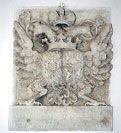|
History of the village and the castle


The small town of Budišov lies approximately between the towns of Třebíč,
Velké Meziříčí and Náměšť nad Oslavou. Its landmarks are the castle and the
church with a weather-cock on a Renaissance tower. On the Věterák hill above
the castle park the visitor can see the remains of a stone wind mill of Dutch type.
The surroundings of Budišov are rich with ponds and woods, the typical rocks of the region are granite and gneiss appearing in the countryside in the form of typical groups of bolders. The oldest occupation of Budišov was proved to be on the site of today's church and graveyard. As the oldest part of the church dates back to the 12th century, the village must have existed at that time. During the 12th - 16th centuries Budišov belonged successively to various noble families; in 1540 the village was promoted to a town and received a seal. Until 1945 the castle was in the posession of numerous noble families, after World War II it became state property. For a short time it housed a school, later it was used as stores and flats. In 1974 the Moravian Museum took over the castle and installed store-rooms of its natural history departments. Besides botanical, mineralogical and palaeolotological collections there is a large part of the collections of the zoological department.
The castle itself is situated on the site of a water fortress from the 13th century, in the 16th century is was adapted into a Renaissance chateau. Its present appearance dates back to the 1720s when it was turned into a luxurious baroque summer residence. In front of its entrance there is a stone bridge with baroque sculptures. The interior of the chateau is decorated with ornamental paintings after chinese patterns and guilded stuccos. In the 18th century a park with numerous sculptures and four ponds was established around the castle. Another interesting historical monument in Budišov is the church of the Assumption and of St. Gothard, mentioned for the first time in 1414. It contains tombs of some of the owners of the dominion and interesting epitaphs.
The surroundings of Budišov are rich with ponds and woods, the typical rocks of the region are granite and gneiss appearing in the countryside in the form of typical groups of bolders. The oldest occupation of Budišov was proved to be on the site of today's church and graveyard. As the oldest part of the church dates back to the 12th century, the village must have existed at that time. During the 12th - 16th centuries Budišov belonged successively to various noble families; in 1540 the village was promoted to a town and received a seal. Until 1945 the castle was in the posession of numerous noble families, after World War II it became state property. For a short time it housed a school, later it was used as stores and flats. In 1974 the Moravian Museum took over the castle and installed store-rooms of its natural history departments. Besides botanical, mineralogical and palaeolotological collections there is a large part of the collections of the zoological department.
The castle itself is situated on the site of a water fortress from the 13th century, in the 16th century is was adapted into a Renaissance chateau. Its present appearance dates back to the 1720s when it was turned into a luxurious baroque summer residence. In front of its entrance there is a stone bridge with baroque sculptures. The interior of the chateau is decorated with ornamental paintings after chinese patterns and guilded stuccos. In the 18th century a park with numerous sculptures and four ponds was established around the castle. Another interesting historical monument in Budišov is the church of the Assumption and of St. Gothard, mentioned for the first time in 1414. It contains tombs of some of the owners of the dominion and interesting epitaphs.
Last modified: